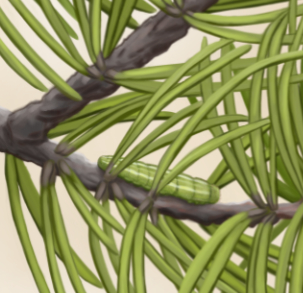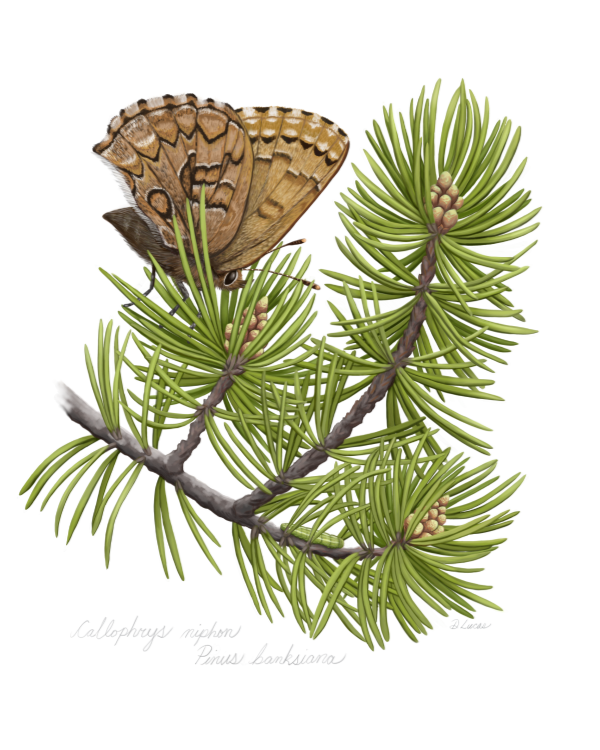Attracting the Eastern Pine Elfin to Your Garden
Eastern Pine Elfin / Callophrys niphon
Wingspan: 2.5 – 3.2 cm (1 – 1.25 in)
The Eastern Pine Elfin butterfly is a member of the Lycaenidae family, commonly called Gossamer-winged butterflies. They are called ‘Gossamers’ because of their shimmering, iridescent wings and delicate appearance. These small to medium-sized butterflies exhibit a wide variety of colours and patterns.
RANGE: The Pine Elfin ranges across southern Canada, to Atlantic Canada, excluding Labrador and also ranges in the eastern United States.
HABITAT: Its habitats are woodlands with small and mature pine trees near open areas where their nectar plants grow. They can also be attracted to gardens with pine trees and nectar plants. Eastern Pine Elfins are rarely found in pine plantations because pine monocultures usually lack nearby nectar sources.
Eastern Pine Elfin Caterpillar Host Plants
The Pine Elfin host plants are various hard pines including:
Scrub pines (Pinus virginiana), Jack pines (Pinus banksiana), and White pines (Pinus strobus).
The Caterpillar

The Pine Elfin caterpillar hatches from pale green, disc-shaped eggs the female butterfly has laid singly on the pine buds and needles. The caterpillars are green with a white side stripe on its side. They are camouflaged amongst the green needles of the pine trees. They eat the buds, flowers and needles of the trees.
The Chrysalis
When the caterpillar is ready to transform into a chrysalis, it creates a loose cocoon in the leaf and needle litter on the forest floor. It forms a dark brown, pellet-shaped chrysalis inside the cocoon and overwinters as a chrysalis.

Eastern Pine Elfin Butterfly Nectar Plants
Eastern Pine Elfins nectar from many different flowers including:
Wild Strawberry (Fragaria virginiana), blueberry (Vaccinium), cinquefoil (Potentilla), and milkweeds (Asclepias).
The Butterfly

The Eastern Pine Elfin butterfly has brown upper wing surfaces with some orange. Its under-wings are brown, reddish brown, and grey with black zigzag patterns. The females are a lighter brown.
Eastern Pine Elfins have one brood per year and fly from mid-April to early June. The males perch high up in the pine trees while searching for females.
Butterflies With Host Trees
It is not unusual for trees to be the larval host plants for Lepidoptera (butterflies and moths). Butterflies such as the Tiger Swallowtail, Mourning Cloak, White Admiral and the Viceroy all have larval host trees and shrubs.
The trees and shrubs that host the most species of Lepidoptera are:
| COMMON NAME | SPECIES SUPPORTED |
| Oak | 534 |
| Willow | 456 |
| Cherry, plum | 456 |
| Birch | 413 |
| Poplar, cottonwood | 368 |
| Crabapple | 311 |
| Blueberry, cranberry | 288 |
| Maple, box elder | 285 |
| Elm | 213 |
| Pine | 203 |
Leaving the Leaves & Needles
Reducing your lawn, growing more native plants and leaving the leaves in your garden are important things to do in a wildlife/butterfly garden. Eastern Pine Elfin butterflies overwinter as chrysalis in the needle and leaf litter in the garden and on the forest floor. There are many different species of insects that shelter, develop and overwinter in leaf litter. Having leaf litter and plants beneath your trees provides shelter for overwintering insects and a soft landing for any chrysalis or caterpillar that may fall from the shrubs and trees.
A Butterfly Garden – is a pollinator/wildlife garden. Never use herbicides or pesticides anywhere near a butterfly garden.
Look but do not Touch – please do not buy butterfly kits or chrysalis’ from commercial breeders or home rear butterflies. It is cruel to the animals, can create unfit populations and spread diseases to the wild species.
Recommended Books:
‘Bringing Nature Home’ by Douglas W. Tallamy
‘Nature’s Best Hope’ by Douglas W. Tallamy
Links to find out more about plants native to your area:
Canadian Wildlife Federation – native plant encyclopedia HERE
Ladybird Johnson Wildflower Center HERE
*Please subscribe to this blog for more posts on butterflies and native gardening.

